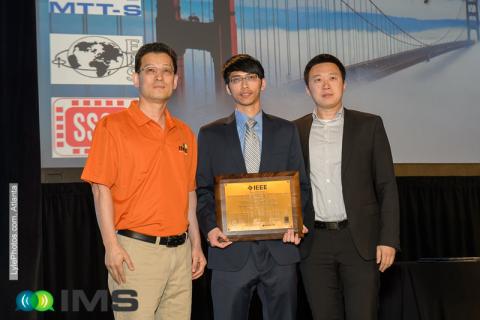ECE Ph.D. students Min-Yu Huang and Taiyun Chi won the 2016 IEEE Radio Frequency Integrated Circuits Symposium (RFIC) Best Student Paper Award.
Min-Yu Huang and Taiyun Chi, Ph.D. students in the Georgia Tech School of Electrical and Computer Engineering (ECE), won the 2016 IEEE Radio Frequency Integrated Circuits Symposium (RFIC) Best Student Paper Award. The conference was held May 22-24 in San Francisco, California, and it is the premier integrated circuits conference focused exclusively on the latest developments in RF, microwave, and millimeter wave integrated circuit technology and innovation.
The title of the award winning paper is "A 5GHz All-Passive Negative Feedback Network for RF Front-End Self-Steering Beam-Forming with Zero DC Power Consumption.” Huang and Chi co-wrote this paper with their Ph.D. advisor Hua Wang, who leads the Georgia Tech Electronics and Micro-System Lab and who holds the Demetrius T. Paris Junior Professorship in the School of ECE.
In this paper, the team proposed and demonstrated an all-passive RF front-end phased-array beam-forming scheme that can autonomously form a receiver beam and track the direction of an unknown incident RF beam. The beam-former only consists of fully integrated passive components and consumes zero DC power. More importantly, the proposed beam-former processes the signal information in both phase and voltage domains, and the nonlinear conversions between the two signal domains are exploited to achieve a negative feedback loop with a large loop gain for high-accuracy phased-array beam-forming and autonomous beam-tracking.
A proof-of-concept, four-element self-steering beam-former is implemented in a standard 130nm CMOS process and occupies a tiny integrated circuit chip area of 4.1mm2. To the best of the team's knowledge, this is the first demonstration of an all-passive negative feedback network capable of performing front-end self-steering beam-forming with zero DC power. The demonstration of this all-passive scheme outperforms any reported active self-steering beam-formers that often consume hundreds of milli-watt or watts of power consumption.
This all-passive RF front-end self-steering phased-array beam-forming scheme can be widely employed in energy-constrained, large-scaled phased-array or MIMO systems, such as 5G communication and high-performance radars, low-power field-deployable sensors, and energy harvesting systems.
